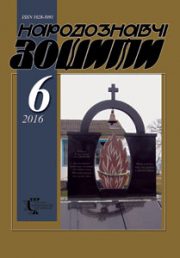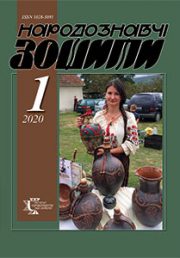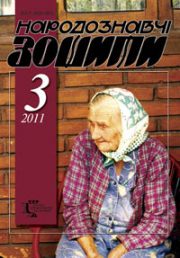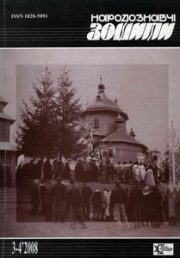The Ethnology Notebooks. 2023. № 2 (170), 396—405
UDK[[061.2:334.71]:677.07](477.86)”19″
DOI https://doi.org/10.15407/nz2023.02.396
KOZAKEVYCH Olena
- ORCID ID: https://orcid.org/0000-0002-8742-4337
- Candidate of arts (Ph. D)
- assistant,
- Seweryn Udziela Ethnographic Museum in Krakow
- Contacts: e-mail: kozakevych.olena@gmail.com
Abstract. Introduction. In the paper, the importance of «The Industrial Aid League» in a development of Galician, of particular Stanislavov region, folk arts and craft (clothes, fabrics, lace) in the early XX century is considered. Such an urgent need to establish an appropriate regional organization in Galicia resulted from the low level of local production, which was lost by imports from abroad; due to the lack of vocational education, which in turn influenced the scope and quality of regional goods; poor promotion of local crafts, especially rural (home) crafts. For this purpose «The Industrial Aid League» was officially approved during the Regional Products Fair in Lviv (1904), which played a leading role in the economic and industrial development of Galicia before the First World War. The organization was represented in over 250 cities, towns and villages, some of which operated in the Stanisіaviv region: the main centers: Stanisіaviv, Kolomyja, Kosiv, Horodenka, Nadvirna, Kuty and others.
However, the significance and effective results of «The Industrial Aid League» remained out of the attention of Ukrainian researchers, which emphasizes the relevance of the article.
The paper aim — to outline main activities of «The Industrial Aid League» in the context of the craft (clothes, fabrics, lace) development in Halychyna (Galicia), of particular Stanislaviv region, in the early XX century.
The novelty of the publication lies in the introduction into scientific circulation the information about the activities of the «The Industrial Aid League» and its significance for the Galician industry of the first third of the XX century. It was found that in the early XX century «The Industrial Aid League» was a leader in the promotion and development of local crafts and in Halychyna (Galicia). Thanks to its activity, the products of Galician manufacturers became known and were in demand not only in the region but also abroad. The main function directions of the organization are identified as well as its leading centers are clarified. This data are published for the first time.
The research object is the activities of «The Industrial Aid League», and the subject is the development of folk arts and crafts in Halychyna (Galicia), of particular Stanislaviv region, in the early XX centuries. The paper methodological basis is the principle of historicism.
The paper source base consists of archival documents, reports, periodicals, photographs from the funds of research institutions of Ukraine and Poland.
Keywords: «The Industrial Aid League», Halychyna (Galicia), Stanislaviv region, craft, folk arts, clothes, fabrics, lace, centers.
Received 11.11.2022
REFERENCES
- Philozoph, T. (2013). The League of Industrial Assistance and its Subcarpathian agendas. Business and Ethos, 2 (10), 34—35 [in Polish].
- Philozoph, T. (2014). Indexes and address books as a source to learn about the economic structure of Eastern Galicia (list of companies and economic entities in the oil industry in 1912). Economy and Science, 14, 159—169 [in Polish].
- Kruk, D.(2015). Institutional forms of supporting the development of Galicia’s industry in the era of autonomy. Scientific Journals of UEK, 6 (942), 93—105[in Polish].
- Kargol, T. (2010). The landed gentry and the industrialization of Galicia at the turn of the 19th and 20th centuries (until 1918). Studies in socio-economic history (Vol. VII, pp. 133—149). Krakow [in Polish].
- Kozak, S. (2014). Economic activity of women in Galicia in the light of the 1912 Industrial and Commercial Index. Studies in socio-econom (Vol. XIII, pp. 81—95). Krakow [in Polish].
- Kozakevych, O. (2012). The League of Industrial Aid: main areas of activity (based on the materials of the first third of the twentieth century). Art History, 12, 107—118 [in Ukrainian].
- Kozakevych, O. (2021).«The Industrial Aid League» and Its Importance in a Development of Folk Arts and Crafts in Galicia in the First Third of XX Century. Ukrainians and their neighbors over the centuries: politics, economy, religion, culture and everyday life (Vol. II, pp. 31—45). Slupsk; Warszawa [in Ukrainian].
- Kozakevych, O. (2020). Exhibition activity of the League of Industrial Aid: preconditions. In Art culture: history, theory, methodology (Pp. 30—32). Lviv [in Ukrainian].
- Kozakevych, O. (2019). Centers of the production of textile products in the Stanislaviv region: beginnings, activities, assortment. In the face of new reality. Stanislaviv and the Land of Stanislaviv in 1918—1923 (Vol. 11, pp. 221—247). Warszawa; Ivano-Frankivsk [in Ukrainian].
- Kozakevych, O. (2016). The League of Industrial Aid: preconditions of creation and beginnings of activity (structure, statutes). Ethnographic Notebooks, 5 (131), 1119—1132 [in Ukrainian].
- Kozakevych, O. (2012). Activity of the Industry Assistance Leage in Eastern Galicia in the beginning of the XXth century. Streszczenia wystąpien «Stan badan nad wielokulturowym dziedzictwem dawnej Rzeczypospolitej» (Pp. 133—136). Byalystok.
- Kozakevych, O. (2013). The activities of the League of Industrial Assistance in Eastern Galicia in the first thirty years of the 20th century. The state of research on the multicultural heritage of the former Republic of Poland (Vol. VI, pp. 391—414). Byalystok [in Polish].
- Kozakevych, O. (2016). «The League of Industrial Assistance» — centers, statutes, activities (1903—1907). Poles in exile (Pp. 55—76). Poznan; Kalish [in Polish].
- Kozakevych, O. (2018). The League of Industrial Assistance: prerequisites for creation and beginnings of activity (structure, statutes). Protection of cultural heritage — intertemporality, memory archive (Pp. 120—139). Poznan; Kalish [in Polish].
- Kozakevych, O. (2020). The role of women in the establishment and operation of the League of Industrial Assistance. In The state of research on the multicultural heritage of the former Republic of Poland (Vol. XII, pp. 581—604). Bialystok [in Polish].
- Lviv Fair of Domestic Products. Industrial Correspondence, 4, 29 [in Polish].
- Central State Historical Archive of Ukraine, Lviv. The case of the activity of the Industrial Aid Society in Lviv (1904—1905). F. 165. Op. 4. Ref. 238 [in Polish].
- (1912). Central State Historical Archive of Ukraine, Lviv. The case of granting subsidies to the League of Industrial Aid in Lviv for the promotion of domestic fishing in Galicia. F. 165. Op. 9. Ref. 132 [in Polish].
- (1907). Central State Historical Archive of Ukraine, Lviv. Materials on the activities of the League of Industrial Aid and participation in it Lubomyrsky Andrew (organizational messages, Lubomyrsky Andrew, invitation forms, etc. F. 835. Op. 1. Spr. 422 [in Polish].
- (1912). Central State Historical Archive of Ukraine, Lviv. Materials on the activities of the League of Industrial Aid and the participation in it of Lubomyrsky Andriy (organizational messages to Lubomyrsky Andriy, invitation forms, etc. F. 835. Op. 1. Spr. 424 [in Polish].
- Central State Historical Archive of Ukraine, Lvov. Report on the activities of the Women’s Society Help Handcrafts in the mountains. Lvov for 1911—1912. F. 165. Op. 9. Ref. 8 [in Polish].
- (1907). Central State Historical Archive of Ukraine, Lviv. Materials on the activities of the League of Industrial Aid and participation in it Lubomyrsky Andrew (organizational messages, Lubomyrsky Andrew, invitation forms, etc. F. 835. Op. 1. Spr. 422 [in Polish].
- (1910). Report of the Central Union of Galician Factory Industry in Lviv on the activities and accounts for the sixth year of existence, 1908/1909. Lvov [in Polish].







